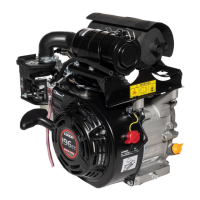STORAGE/
TRANSPORTING
When adding
a
fuel
stabilizer
,
fill the fuel tank with fresh gasoline. If only partially filled,
air
in
the tank will promote fuel deterioration during storage. If you keep
a
container of
gasoline for refueling, be sure that
it
contains only fresh gasoline.
1.
Add fuel stabilizer following the
manufacturer
'
s
instruct
i
ons
.
2.
Af
te
r adding
a
fuel stabilizer, run the engine outdoors for
10
minutes to be sure that
treated gasoline has replaced the untreated gasoline
in
the
carburetor
.
3.
Stop the engine, and move the fuel valve to the OFF position.
DRAINING
TH
E
F
U
EL T
A
NK AND CARBURETOR
1.
Place an approved gasoline container below the
carb
u
retor
,
and use
a
funnel to avoid
spilling fue!.
2.
Remo
v
e
the carburetor drain bolt and
sed
i
ment
cup
,
and then move the fuel valve
l
eve
r
to
t
h
e ON position.
MSHER
DR,8JN
Sa.T
'
F
UEL
V,8L\.
f
LE
V
E
R
3
.
After
al
l
th
e
fuel has
d
r
a
i
n
into the contain
e
r,
reinstall the drain
b
olt and sediment cup.
T
i
ghten them securely.
AWARNING
•
The length of time that gasoline can be left
in
your fuel tank and
carburetor without causing
func
t
ional problems will vary with
such factors as gasoline
blend
,
your storage
temperatures
,
and
whether the
fue
l
tank
i
s
partia
l
ly or completely filled. The air
in
a
pa
r
tially
fi
l
led fuel tank
promote
s
fuel
deteriorat
i
on. Very warm
storage temperatures accelerate fuel
deter
i
oration. Gasoline will
oxidize and
deter
i
orate
in
storage
.
Deteriorated gasoline will
cause hard starting, and it
leav
es
gum deposits that clog the fuel
system. As
ares
u
it
,
If
the engine is not used for more than one
month
,
the tue
l
oi
l
shall be
drai
n
ed thoroughly to prevent from
deterioration of the fuel
i
n
fuel
s
ystem and carburetor.
•
The failures of fuel system or engine performance arisihg from
improper storage are beyond
t
h
e
scope of the
warranty
.
-20-

